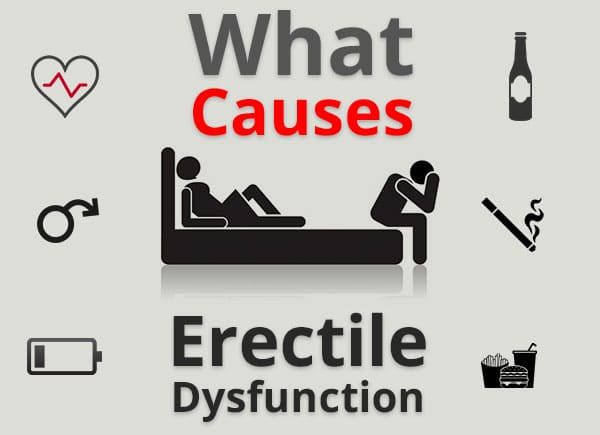Erectile Dysfunction
Erectile dysfunction (ED), also commonly referred to as impotence. It is the general and prolonged inability of a man to obtain or sustain a penile erection that is hard or strong enough to provide for successful sexual intercourse. While the vast majority of men, if not all, experience erection difficulties at some point in their sexual maturity, ED is an ongoing, repetitive problem that requires the assistance of a physician in diagnosis and treatment.
Erectile dysfunction can be troubling for both the affected man and his partner. Erectile dysfunction can cause relationship stress, anxiety, depression, psychological pain, self-esteem issues, and immense sexual frustration. In the past, there were stigmas associated with ED.
However, as time and medical awareness have progressed, it has become clear that erectile dysfunction may be indicative of other health issues or organic causes. These causes, once determined, may be easily treated, and the ED can be alleviated, causing a return to normal sexual performance.
It is reported that about 40 percent of adult males experience ED at some point in their lives. Once accepted as an embarrassing yet normal sign of aging, it is now known that Erectile Dysfunction (ED) is a sign that something is not right within the man’s body.
Quite simply, a non-functioning penis may be a clear sign of health problems such as diabetes, heart or vascular issues, kidney problems, and even arsenic poisoning as well as several disorders. Sexual dysfunction can also be a side effect of anti-depressants, smoking, alcohol consumption, and other lifestyle choices. Regardless of the root cause, ED is generally quite treatable.
Indications and Risk Factors of Erectile Dysfunction

ED is easily discovered. As ED is essentially a repeated inability to gain or maintain an erection for healthy sexual activity. The problem becomes apparent through failed sexual activity or penis performance without the same rigidity as regularly experienced in the past. As part of a sure diagnosis, a doctor will evaluate the suspected ED through a series of questions about the patient’s sexual activity and recent changes within that activity.
To diagnose ED, some questions a health practitioner might ask the patient experiencing impotence could involve the following subjects:
- Current and past sexual function, frequency of activity
- When the ED was noticed and how often it has occurred
- Relationship status and situation
- Medical history, injuries, and problems
- Medications, lifestyle (drugs, alcohol, smoking, exercise)
There are several common risk factors among men experiencing ED. This does not imply that all men with erectile dysfunction will be part of these categories, but one or more of these often apply. Some of those are:
- Smoking
- Age 50 years or older
- High blood pressure
- Elevated cholesterol levels
- Heart disease
- Diabetes
Causes of Erectile Dysfunction

Understanding how an erection works as a healthy body function also helps in the realization that impotence is not a disorder of shame and may be easily treated. The human body works like a machine. All parts must be in working order for the overall machine to work well as designed. One slightly damaged part can limit the quality of operation of the rest, if not stop the machine’s functioning altogether.
An erection requires more of the body’s machinations to be in good health than one might suspect. For an erection, the nervous system, vascular system, hormones, psychological health, and many other factors are involved. With so many powers at play, it is easy to see how one malfunctioning aspect can cause ED.
In the absence of ED, a healthy erection may be initiated either by touch or through emotional or erotic mental stimulation. Regardless of whether thought or deed start the process, the brain is responsible for kicking off an erection’s entire physical operation through electrical impulse. The nervous system then takes those electrical signals to the blood vessels, which in turn direct blood to the penis.
The penis becomes erect and sexually ready when it is filled with blood. At that time and as long as the blood flow maintains the erection, the penis is functional toward the eventual outcome of ejaculation. After ejaculation, the brain shuts off its signal for the erection, and the rest of the process ends accordingly.
The surface causes of erectile dysfunction may be restriction or interruption of blood flow to the penis, low testosterone hormone levels, prescription or over-the-counter medication interactions, nerve damage, psychological or emotional problems, or even cancer treatments such as radiation therapy or surgery. Bad lifestyle choices like alcohol overuse, smoking, or drug use may also inflict erectile dysfunction. Lifestyle-affected problems such as obesity and lack of exercise are additional known concerns leading to ED.
Once the surface cause of ED is determined, a doctor must look even more closely to see if one of a multitude of potential health problems or diseases is in effect. As an example, once a physician sees that blood flow to the penis is restricted and thus is causing ED in that particular patient. The doctor will then need to figure out what is causing restricted blood flow.
The patient might be diagnosed with heart disease, or another disorder could be stopping the blood flow and causing erectile dysfunction. A doctor will find the surface problem, whether medical or psychological and then will work to diagnose the root of that problem. The root cause of erectile dysfunction can then be treated.
There is not one unified test, which determines a cause for individual erectile dysfunction. Instead, the entire body’s health, lifestyle, and medical history are examined to lead the physician down the pathway to diagnosis of the patient’s own Erectile Dysfunction. Once the cause is discovered, treatment may begin, and healthy sexual function can be restored.
Treatments for Erectile Dysfunction
Treatment for erectile dysfunction starts before there is an issue of impotency in the first place. To increase potential that ED will not be a factor in a man’s lifetime, a well-balanced diet, a healthy lifestyle free of smoking or drug us. Moderation in alcohol consumption and ongoing aerobic exercise are all methods of maintaining a healthy body toward the prevention of sexual problems.
When ED has been diagnosed, successful treatment can most often be provided. This treatment is generally considered “on-demand,” as an erectile dysfunction medication or device is utilized to provide an erection precisely when desired.
The patient must also then work to cure the root cause of the ED, whether that cause is lifestyle-related, psychological, or medical. Merely restoring the erection is not a cure for overall concerns, but will alleviate the ED and restore sexual activity and satisfaction on a more significant path of health and well-being.
For what most experts consider uncomplicated ED, oral medication is the most common treatment. These pills relax the muscle cells in the penis to allow for increased and unrestricted blood flow and improve the rigidity of the erection, thereby eliminating the ED at the penis, itself.
Over 80% of men with ED treated with these pills enjoy positive results. In those whose impotence is not helped by oral medications, injectable medications and suppositories are also options.
For men who do not wish to take oral medication or use a prescription through injection or suppository, an external vacuum device may be the next possible solution for their ED. Also commonly referred to as a “penis pump,” such a device offers a relatively quick and immediate rigidity to the penis upon use. In other words, the vacuum is used just before sexual intercourse and as needed.
If the two above courses of action do not work or are not recommended for an individual’s ED, a surgical penile implant is another option. Survivors of some forms of cancer or other medical issues may need to utilize an implant for their ED if a doctor does not believe medication or a vacuum device will be safe or effective for their treatment.
This prosthetic implantation can generally be performed in an outpatient surgical setting. The implant shows about 90 percent success in ED patients. Failure of the device or prosthesis infection are the two side effects from this type of procedure for ED.
Medications Prescribed to Treat Erectile Dysfunction
Several prescribed formulations are commonly used in the treatment of erectile dysfunction with high success rates. These are frequently advertised on television and in other mainstream media and are no longer stigmatized. Some of those erectile dysfunction medications, known as phosphodiesterase-5 inhibitors (PDE-5), are:
- CIALIS ( tadalafil )
- LEVITRA ( vardenafil HCl )
- VIAGRA ( sildenafil citrate )
- STENDRA ( avanafil )
These drugs are each prescribed under various brand names, as developed by major pharmaceutical companies. They are all found to be relatively safe and effective for ED treatment in men of all races and ages. You may also try some of the top testosterone boosters like Virectin, made up of all-natural ingredients, hence no side-effects.
It is always advised that men prescribed nitrates for heart issues consult with their physician before using erectile dysfunction medications. However, even men with heart issues may safely take these drugs under medical supervision.













One thought on “What Is Erectile Dysfunction (Impotence)?”
Comments are closed.